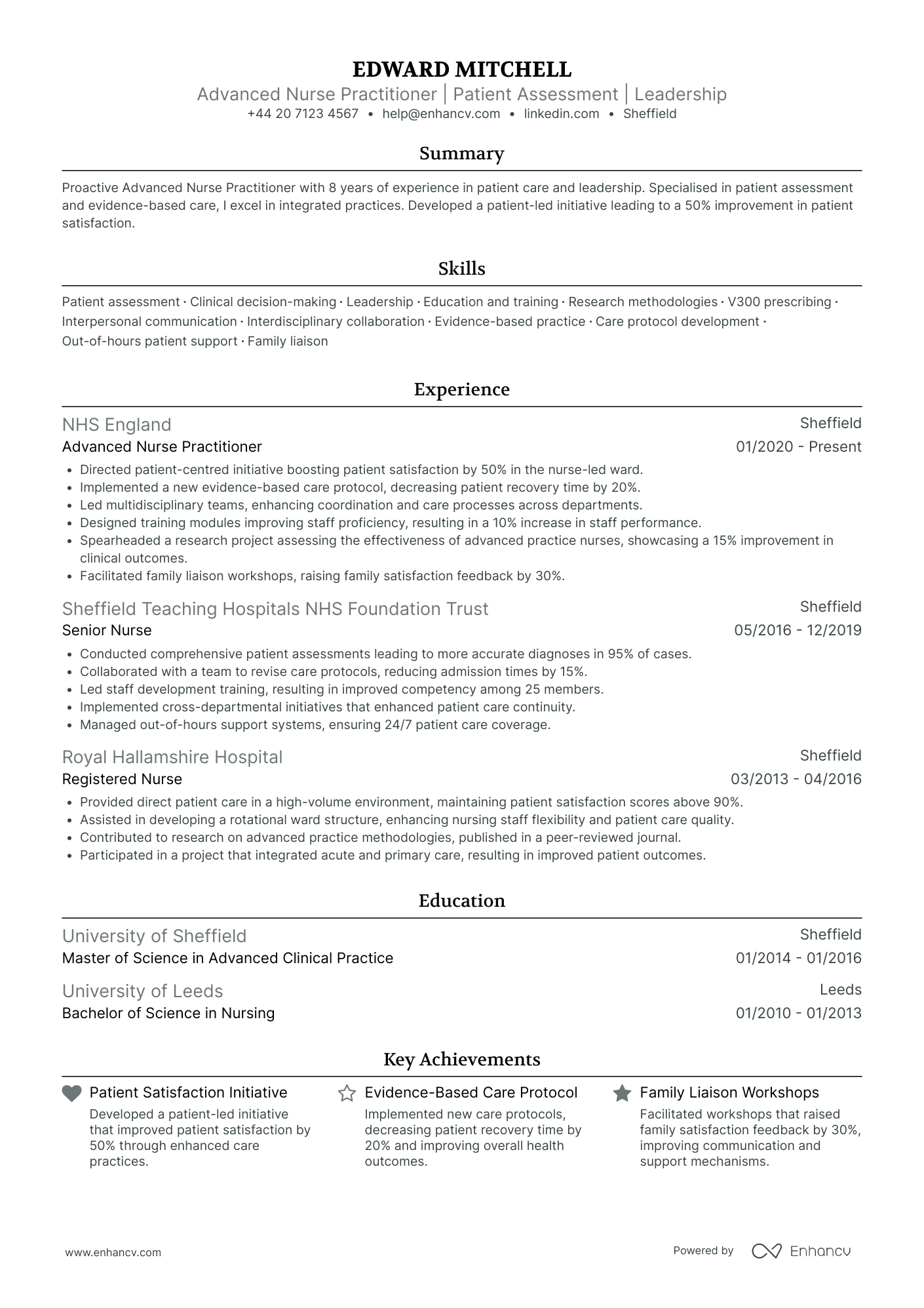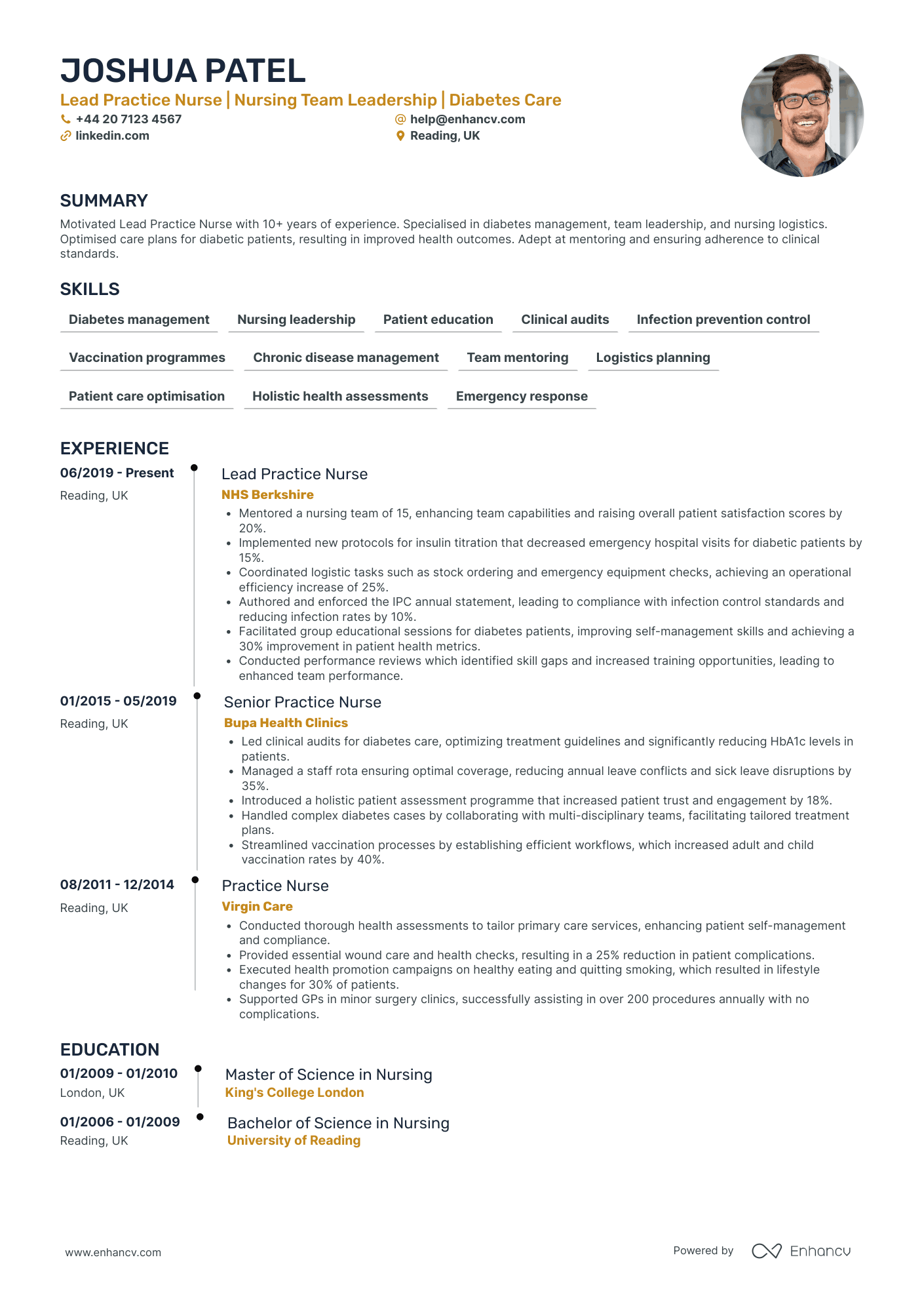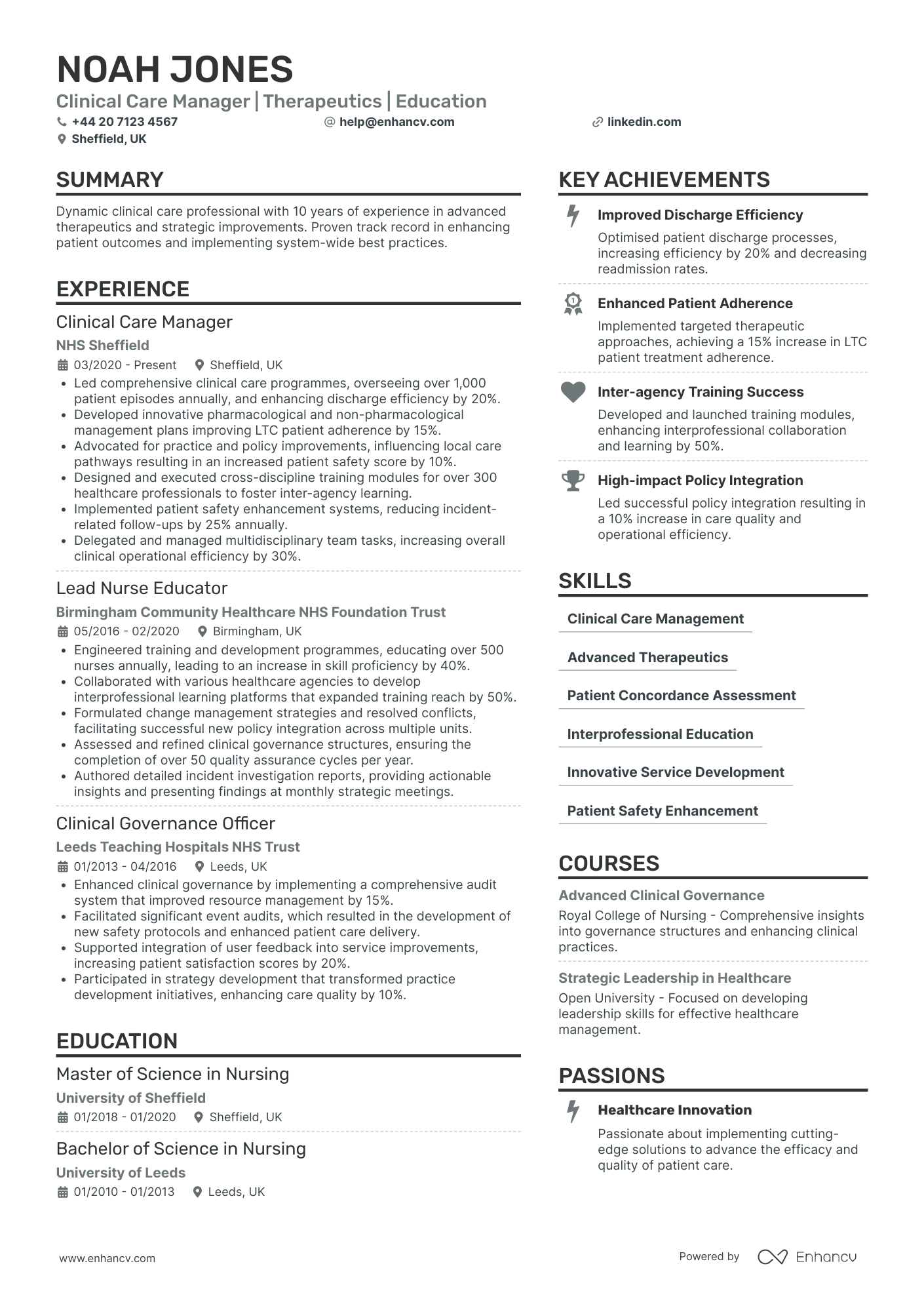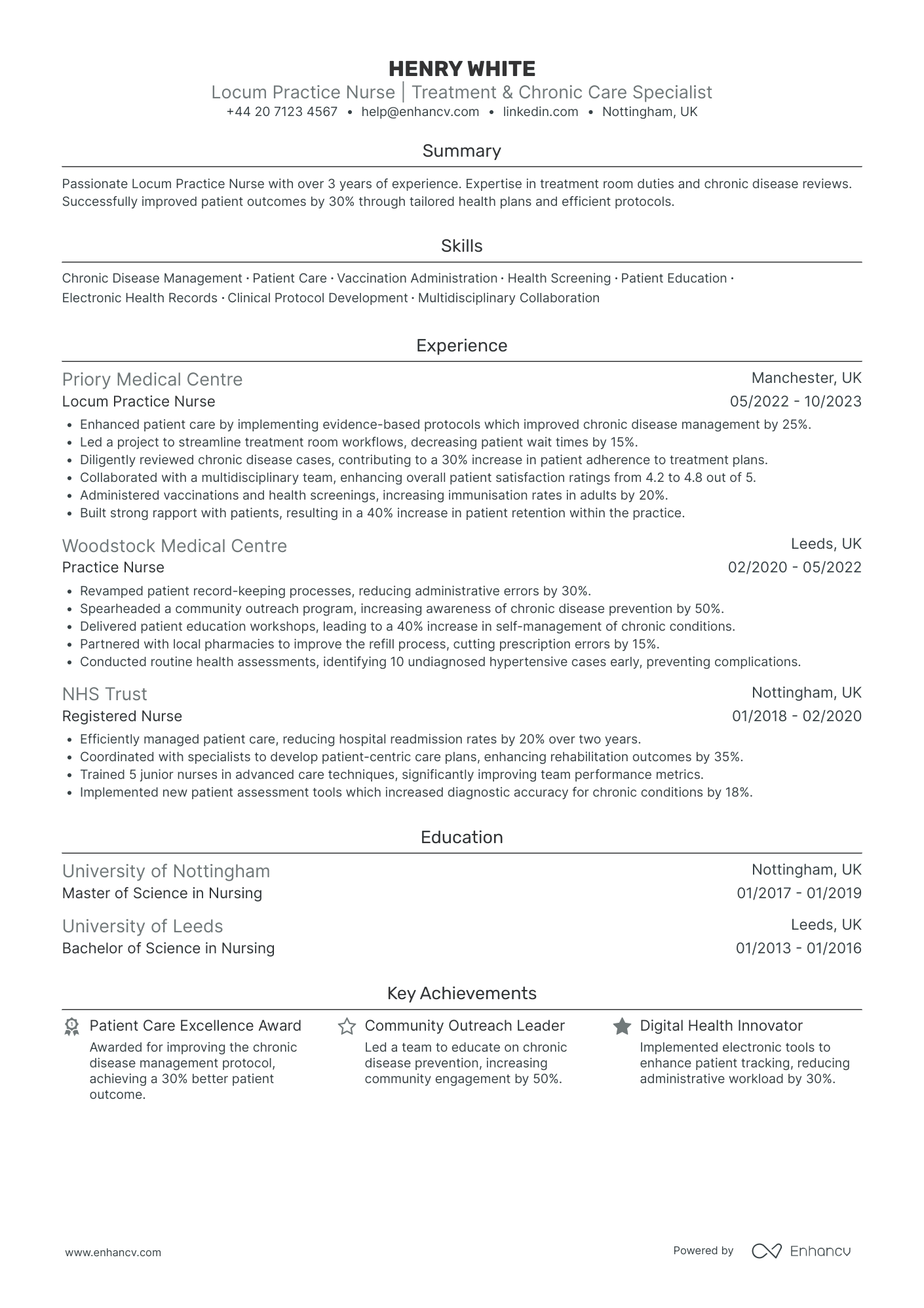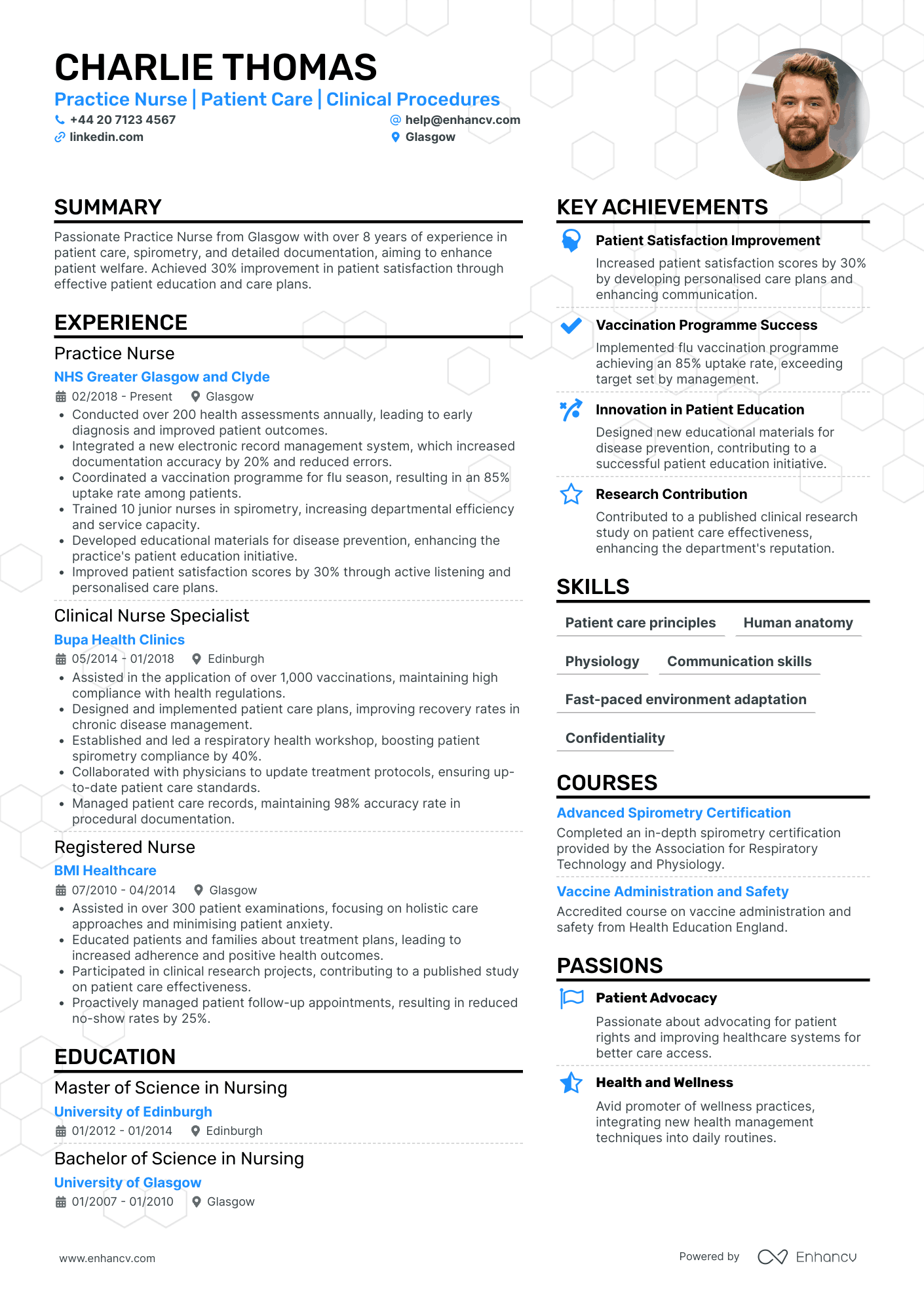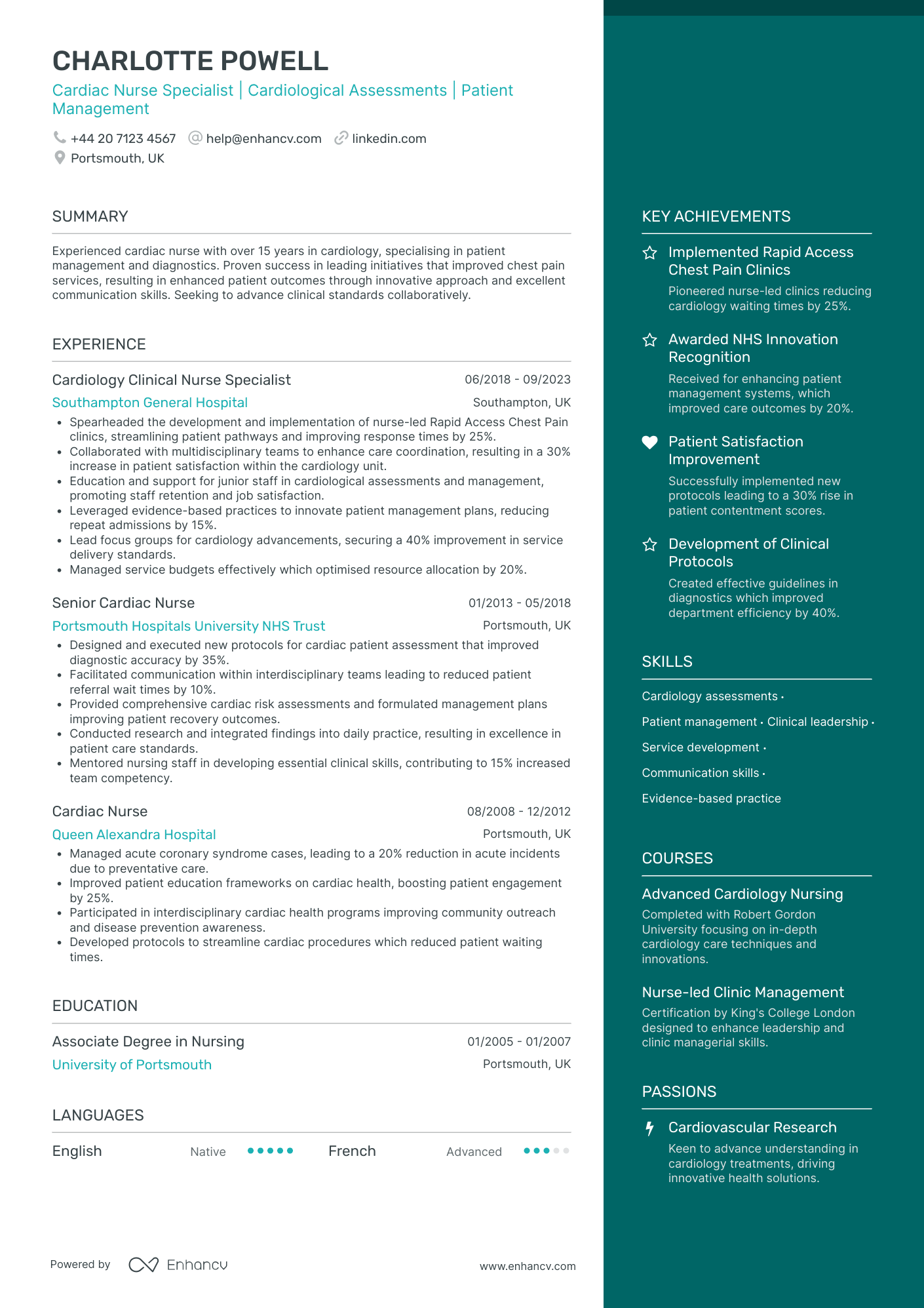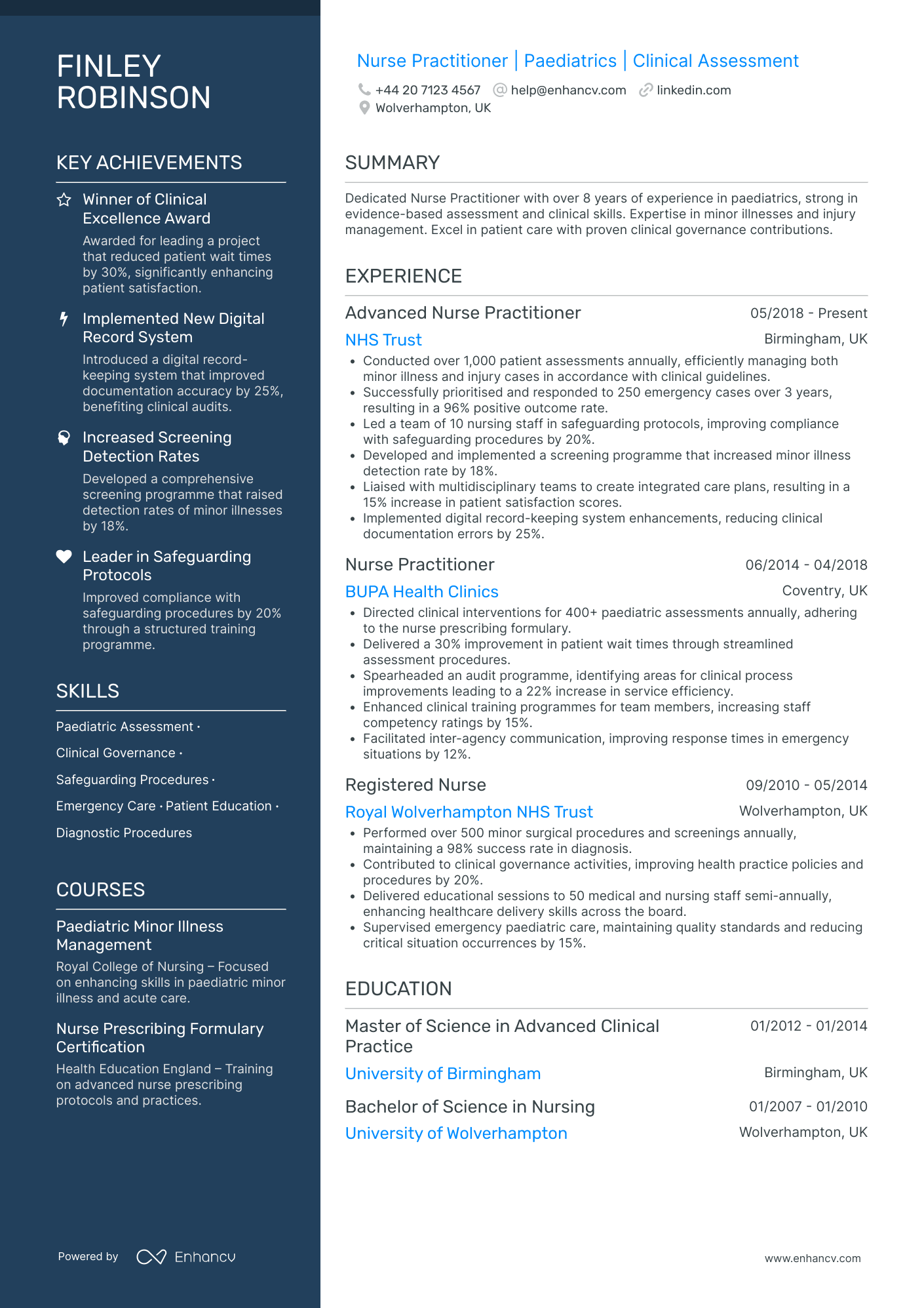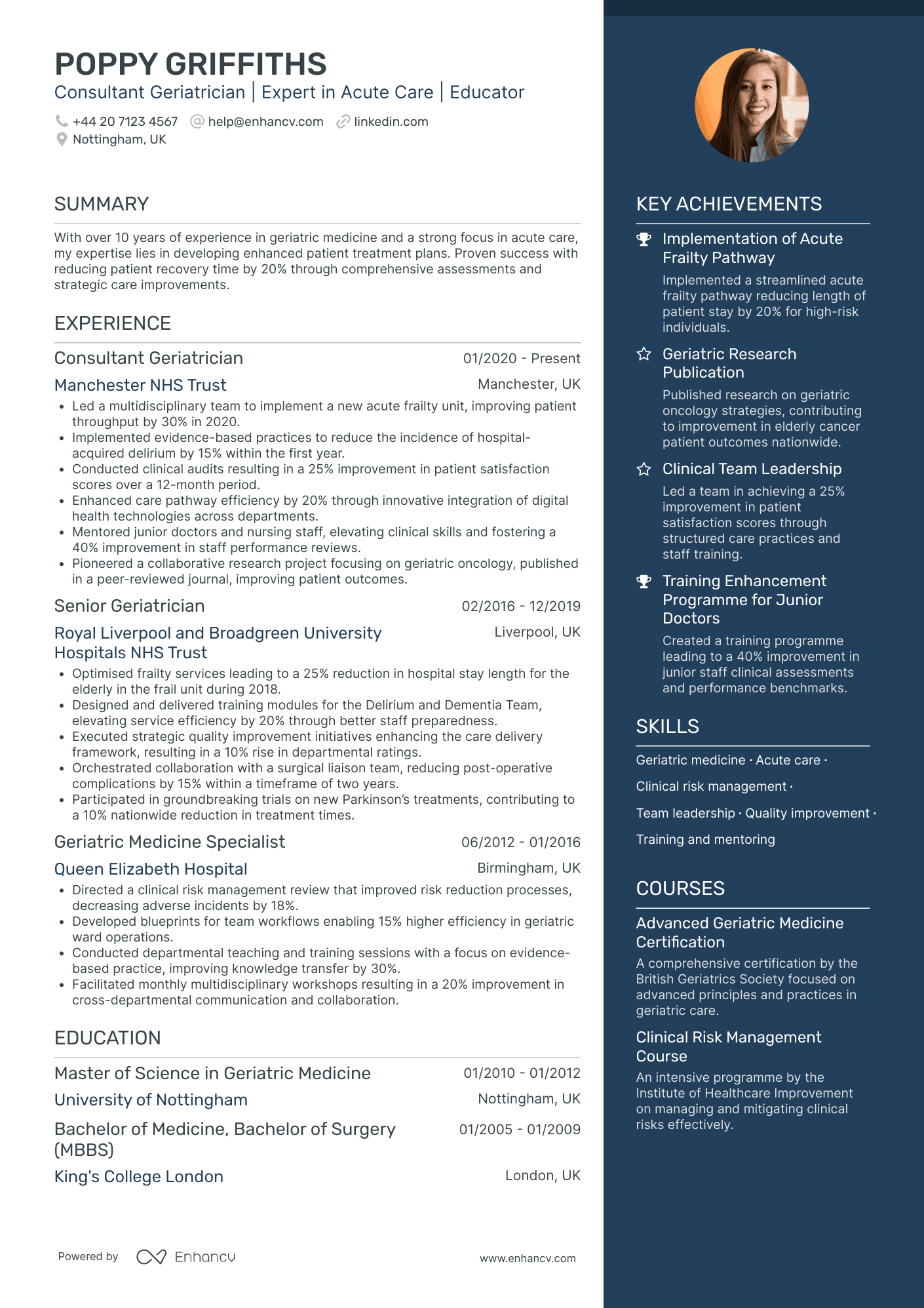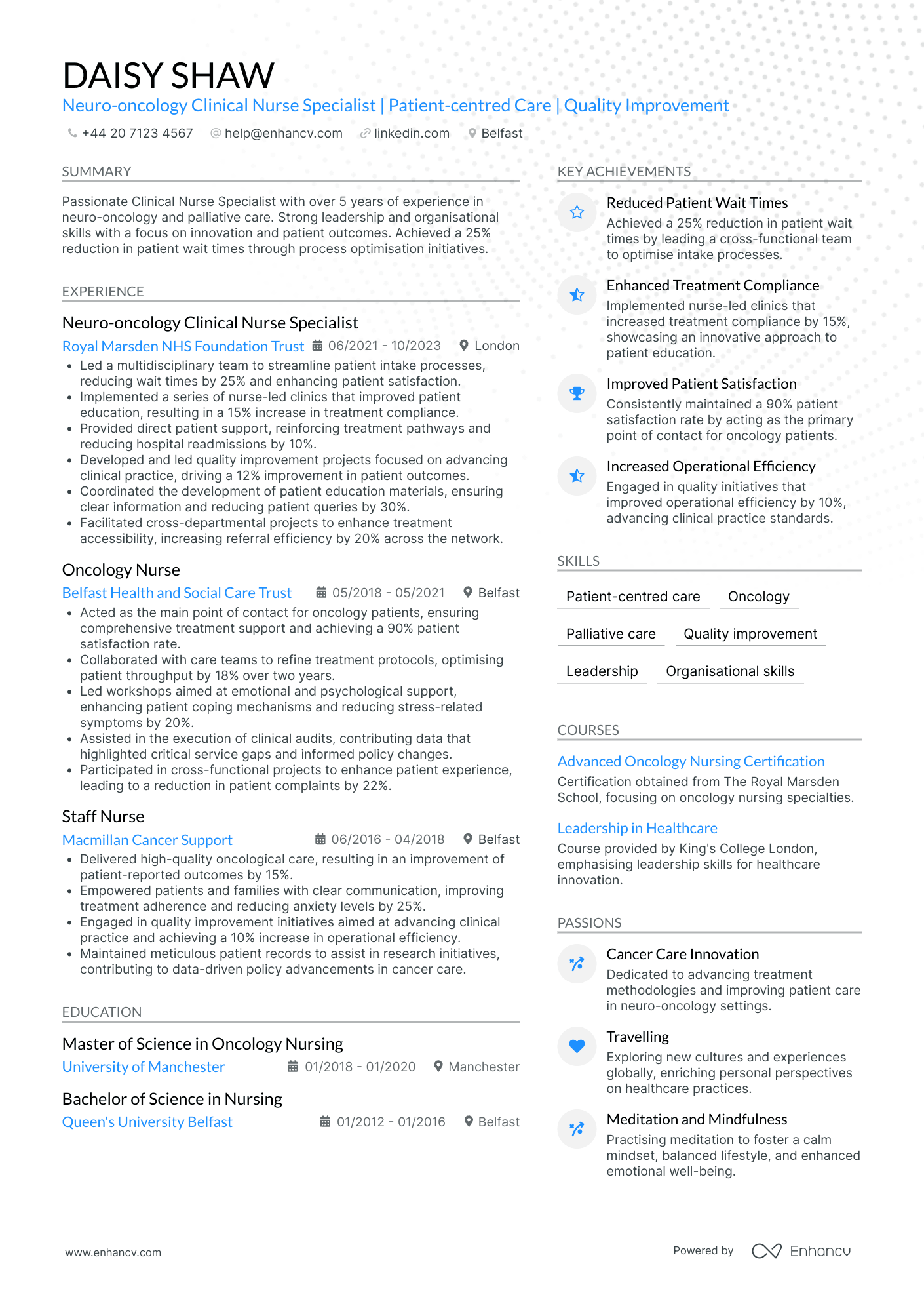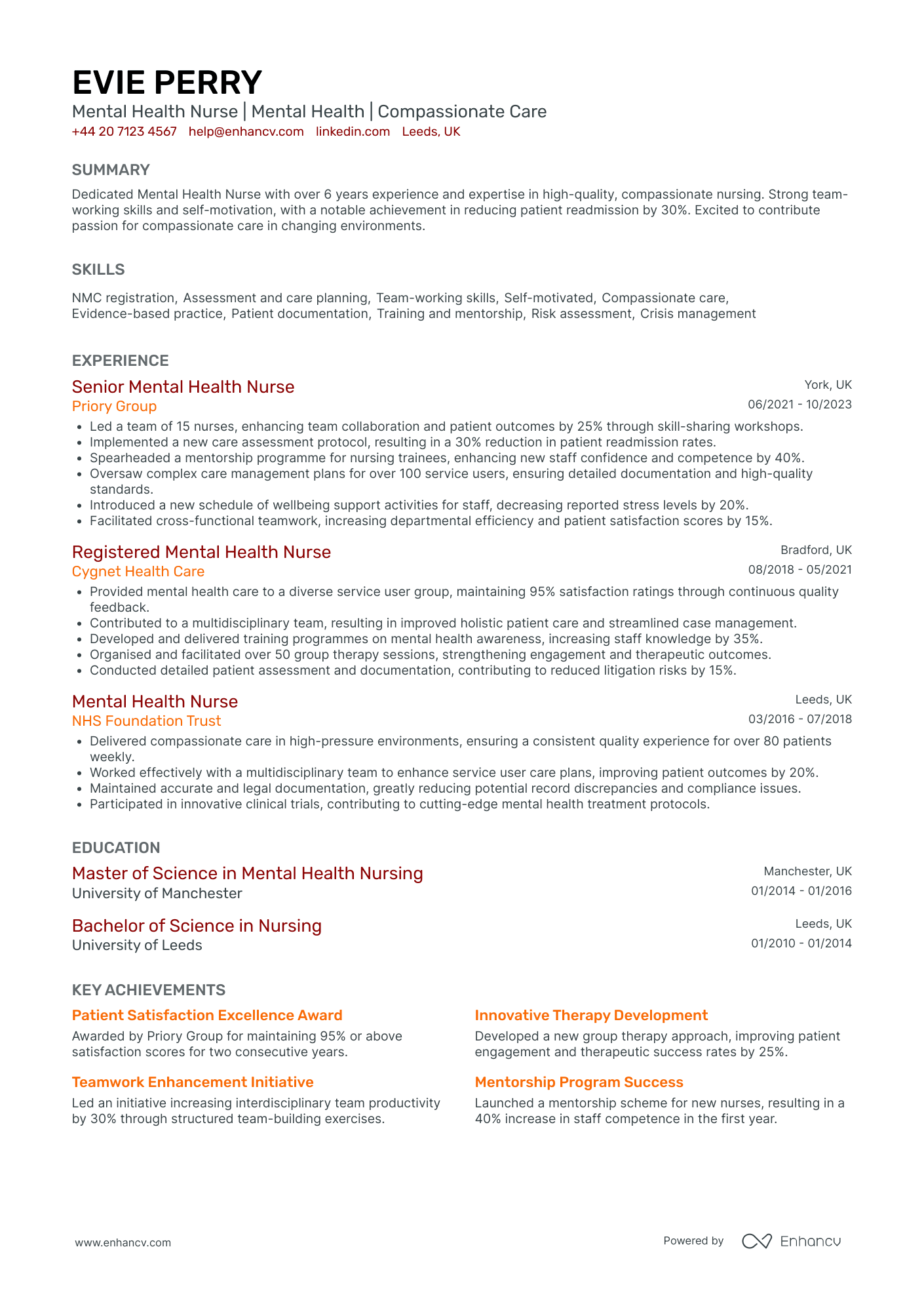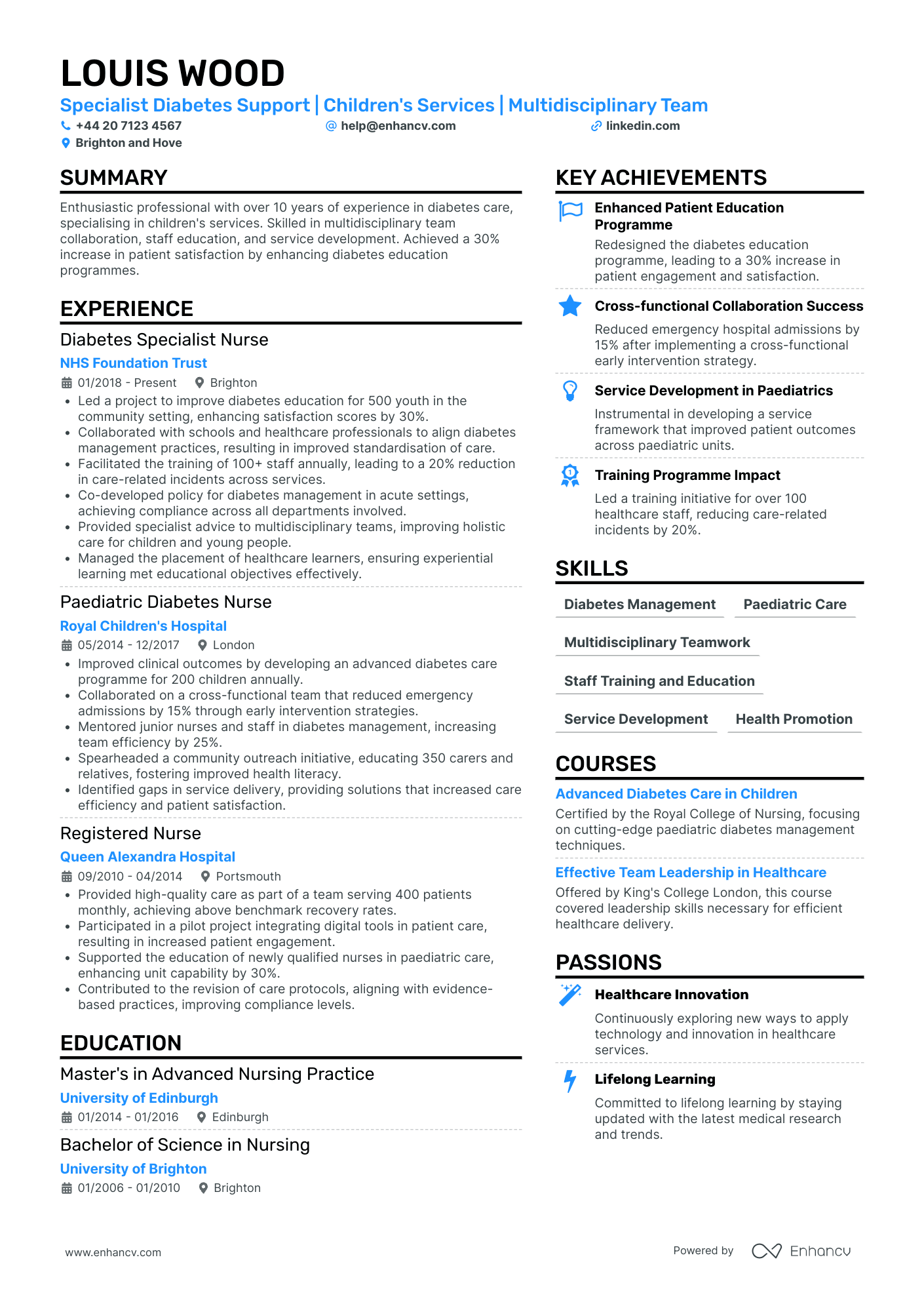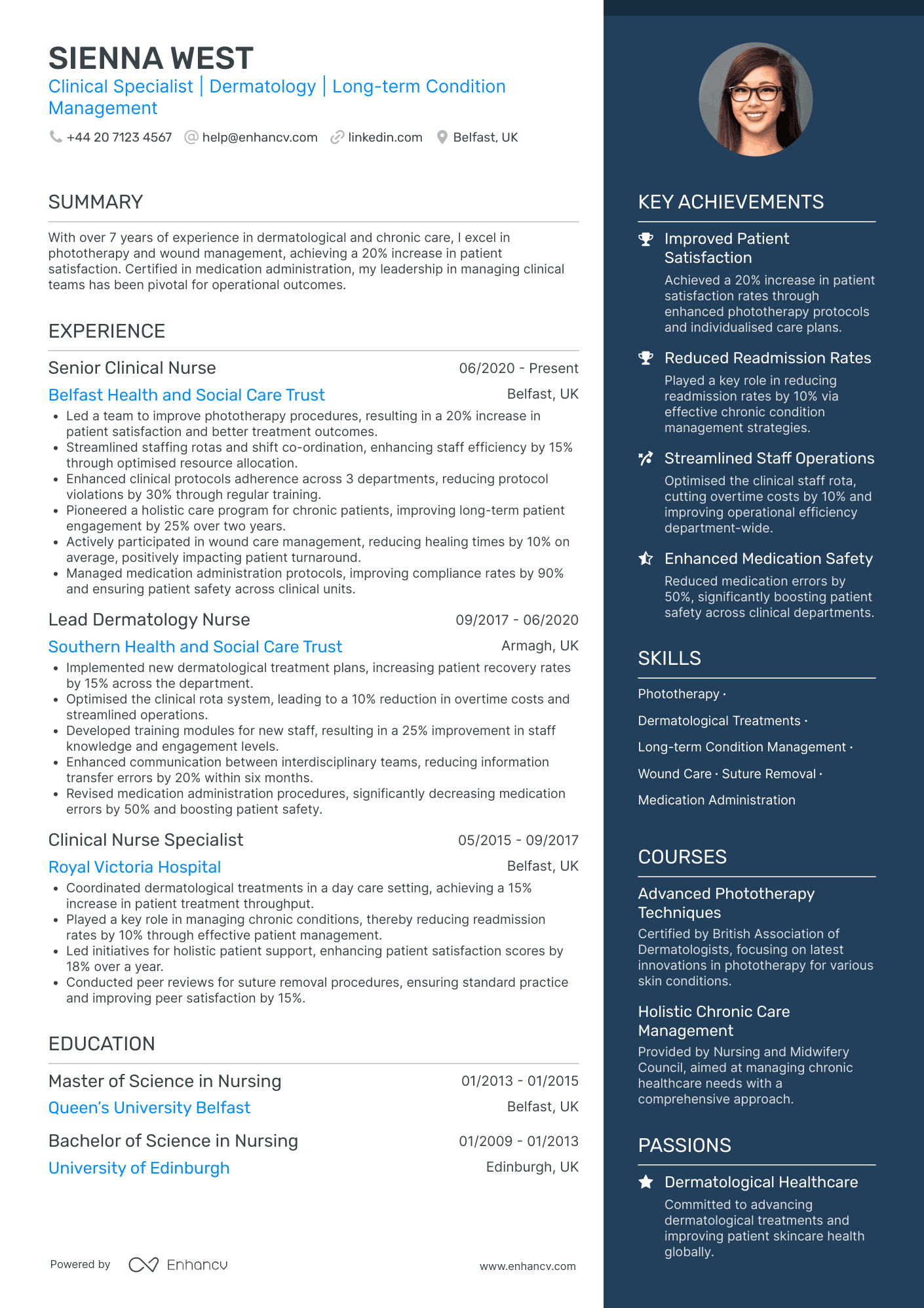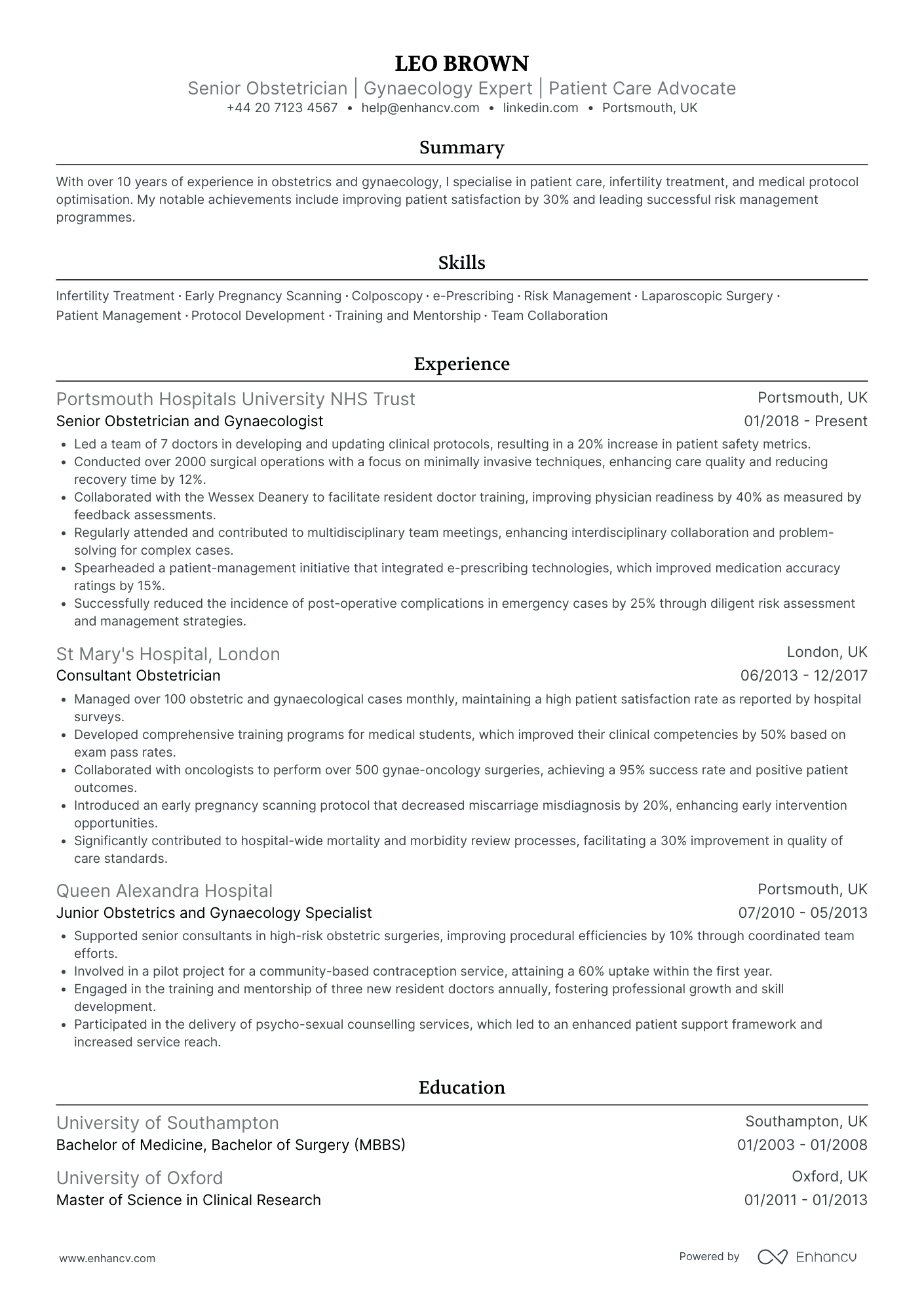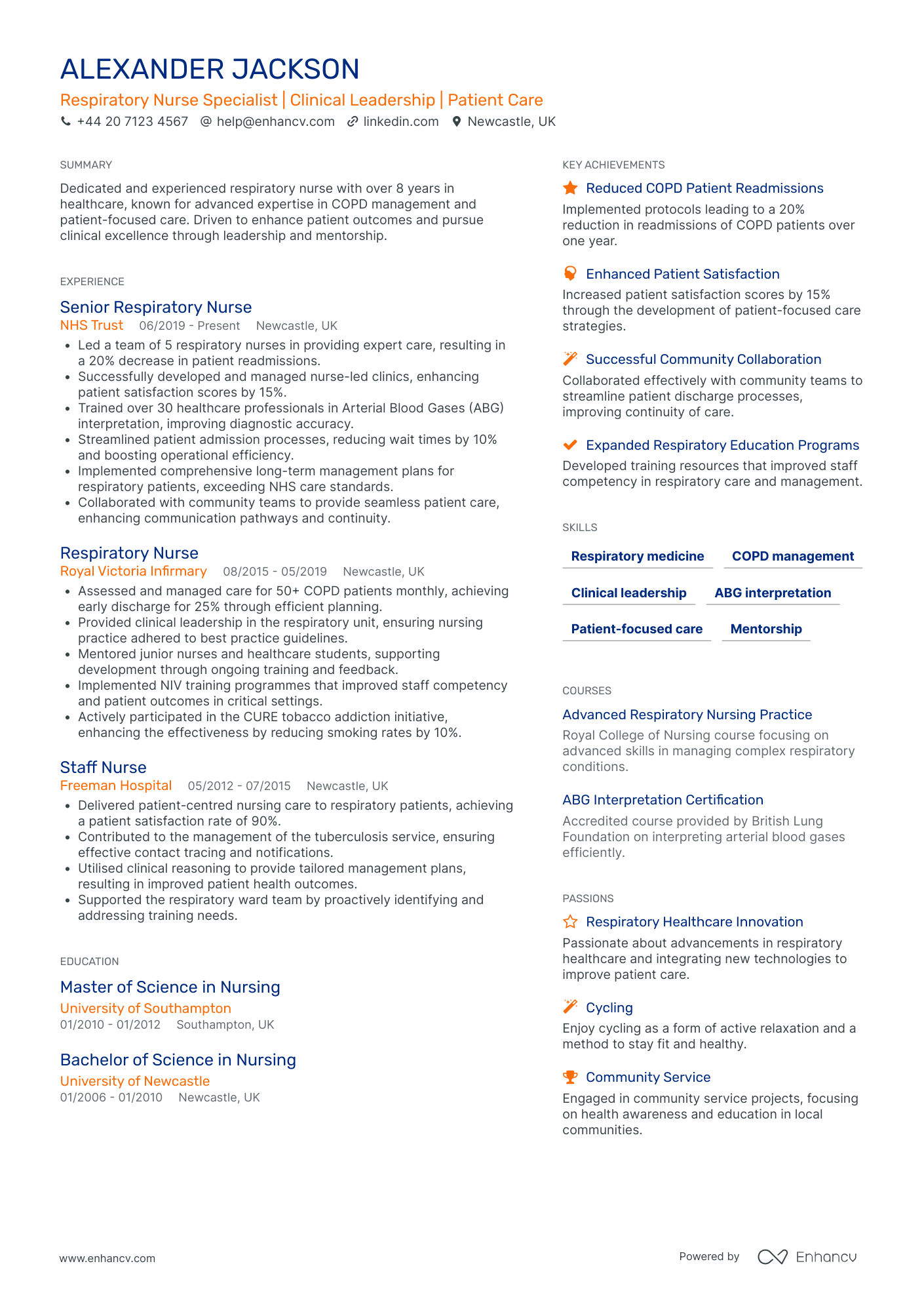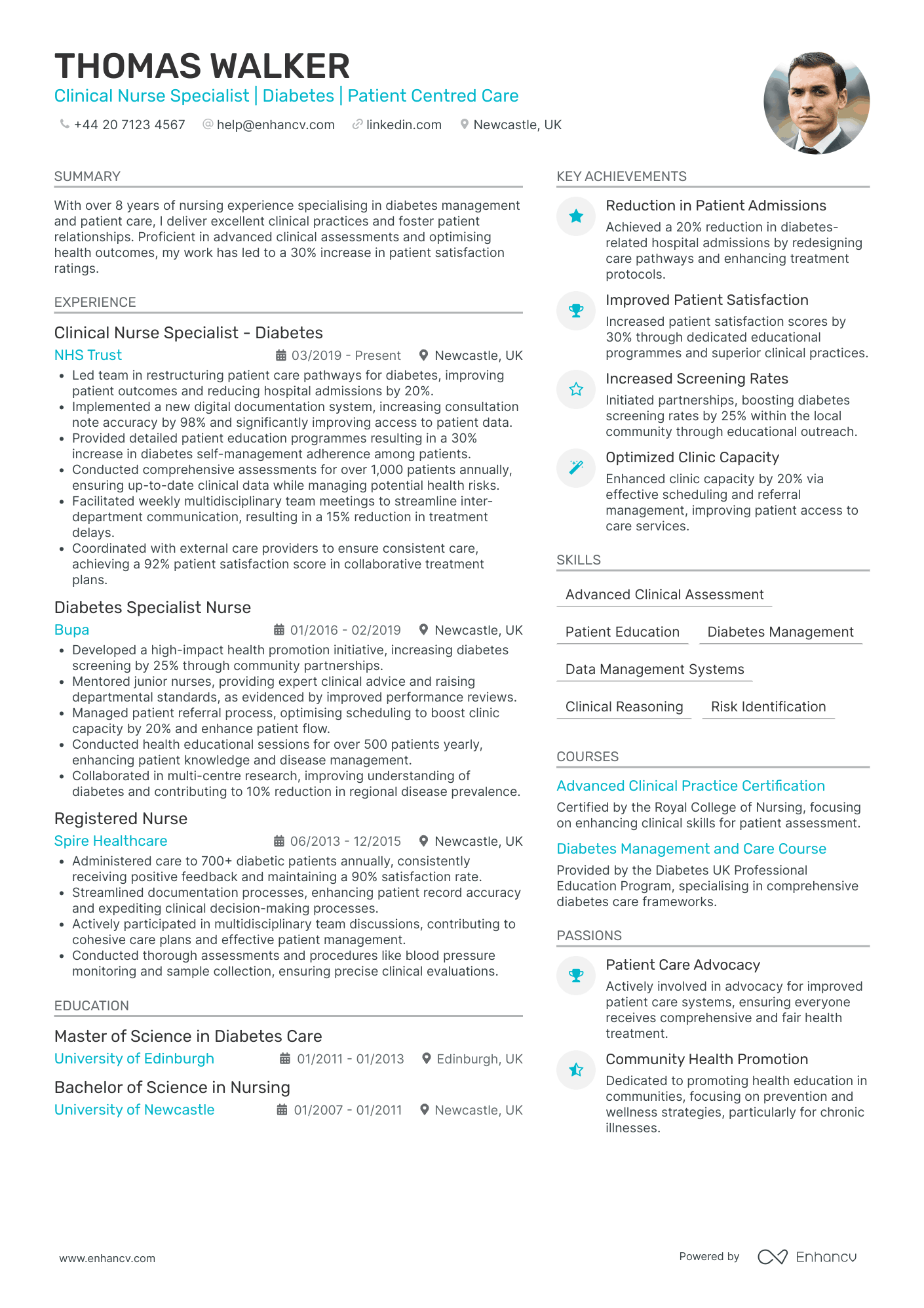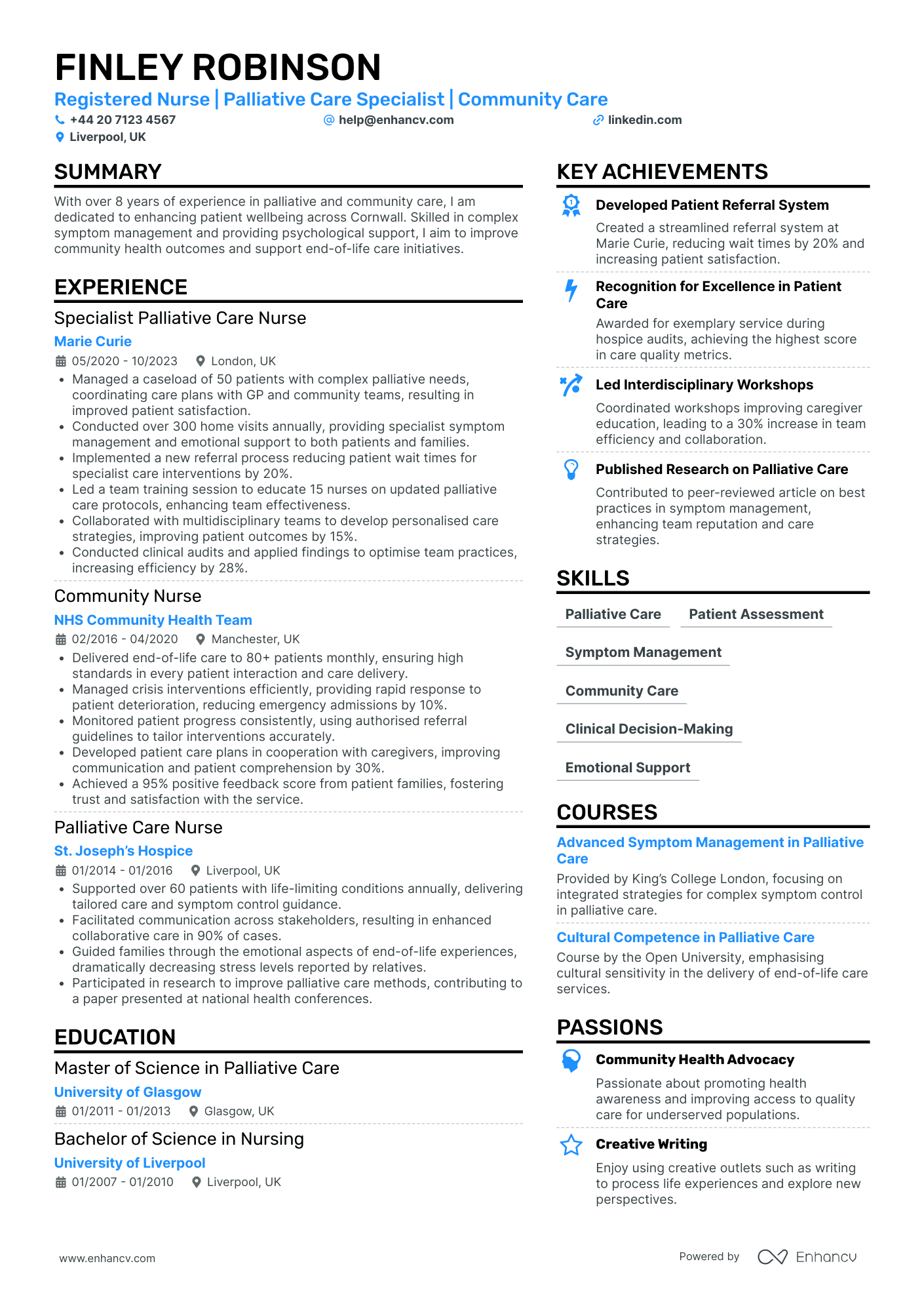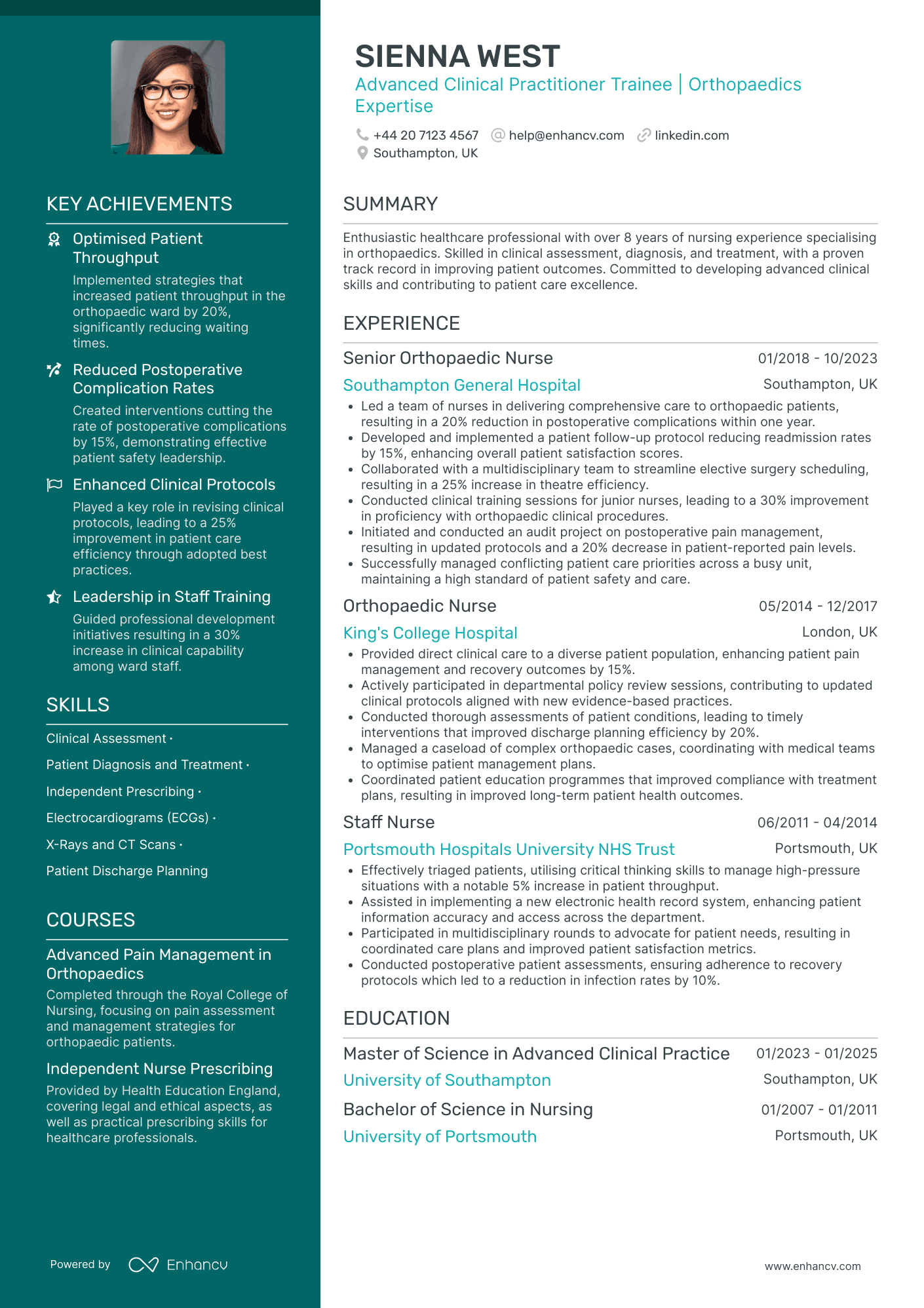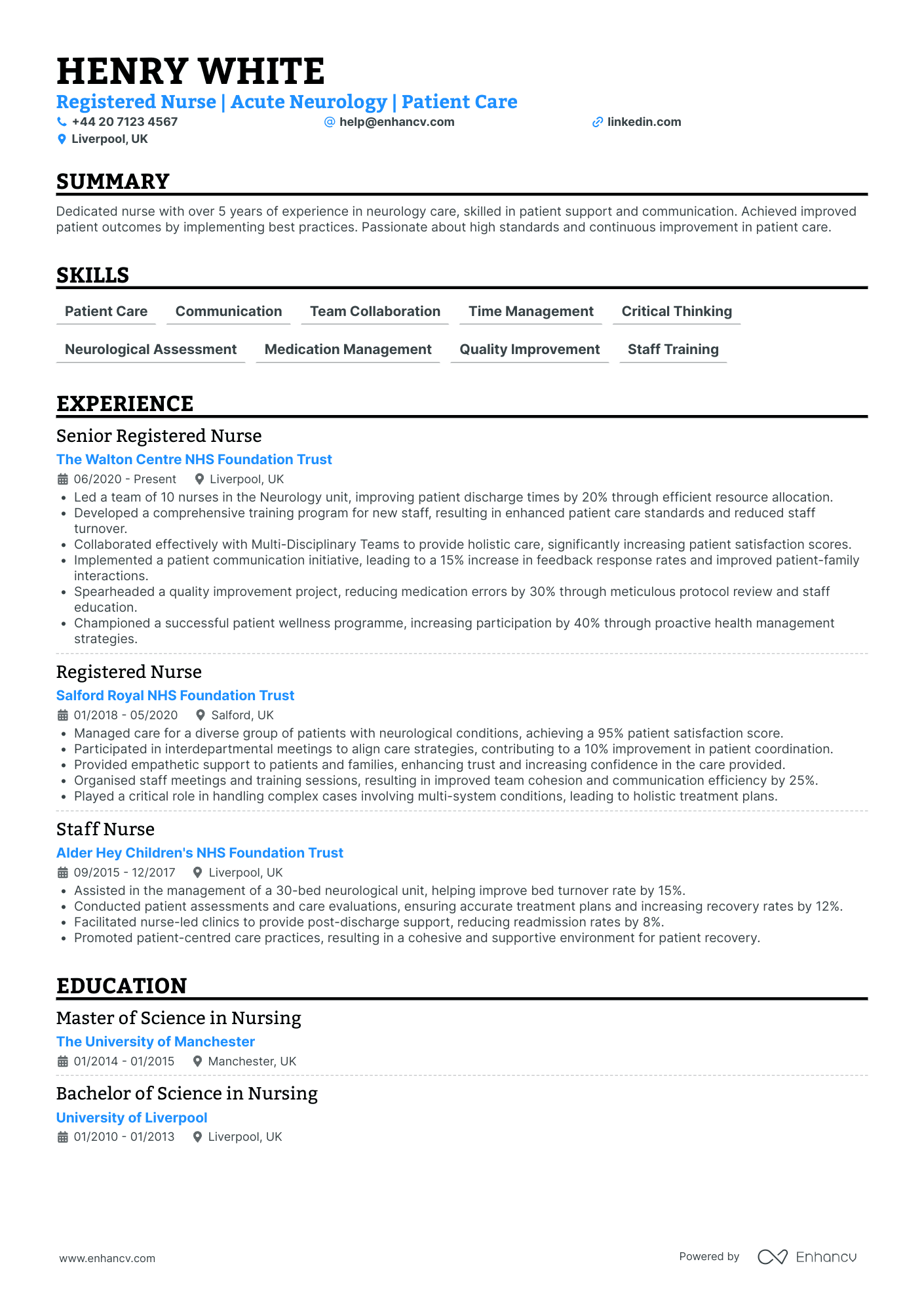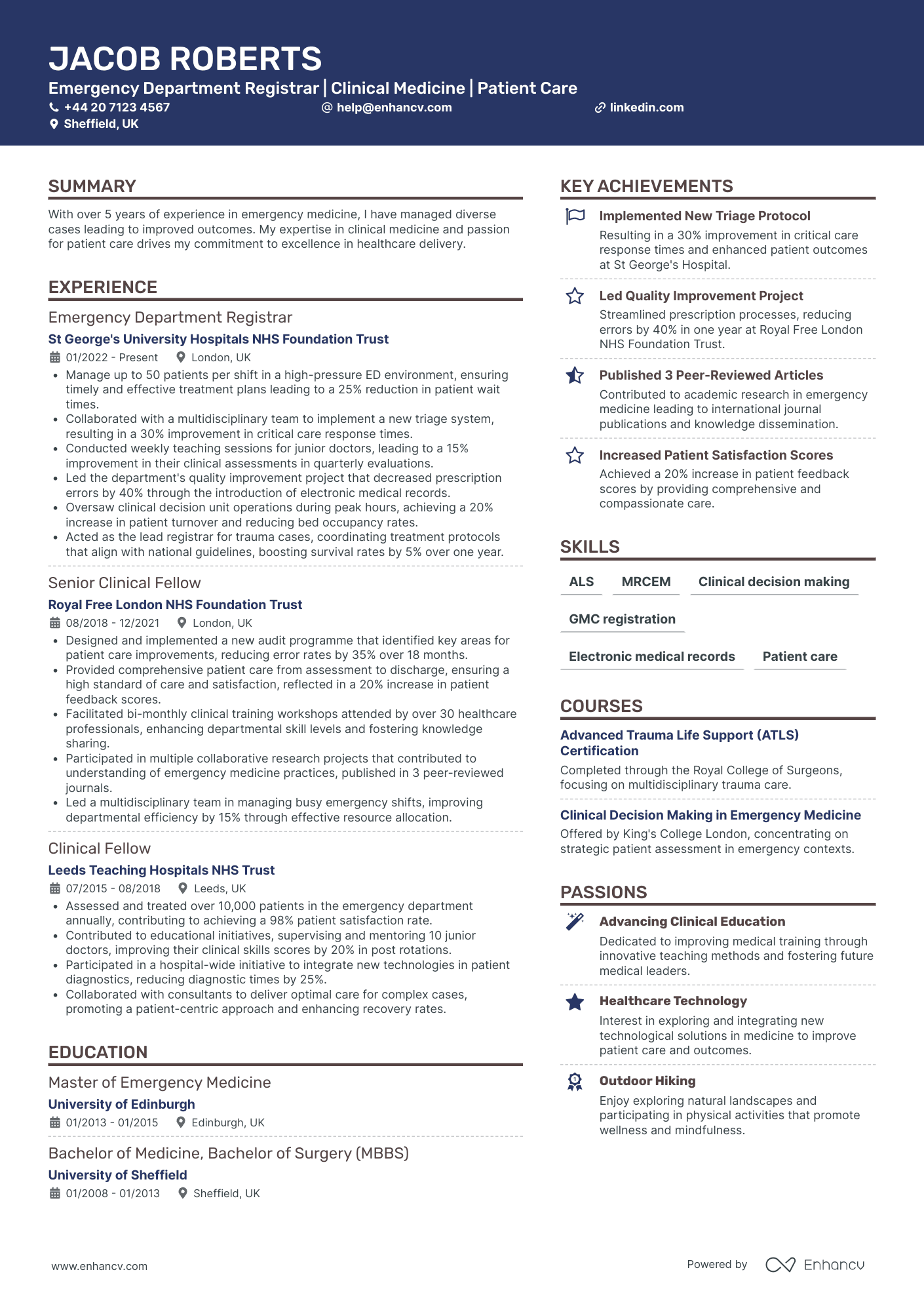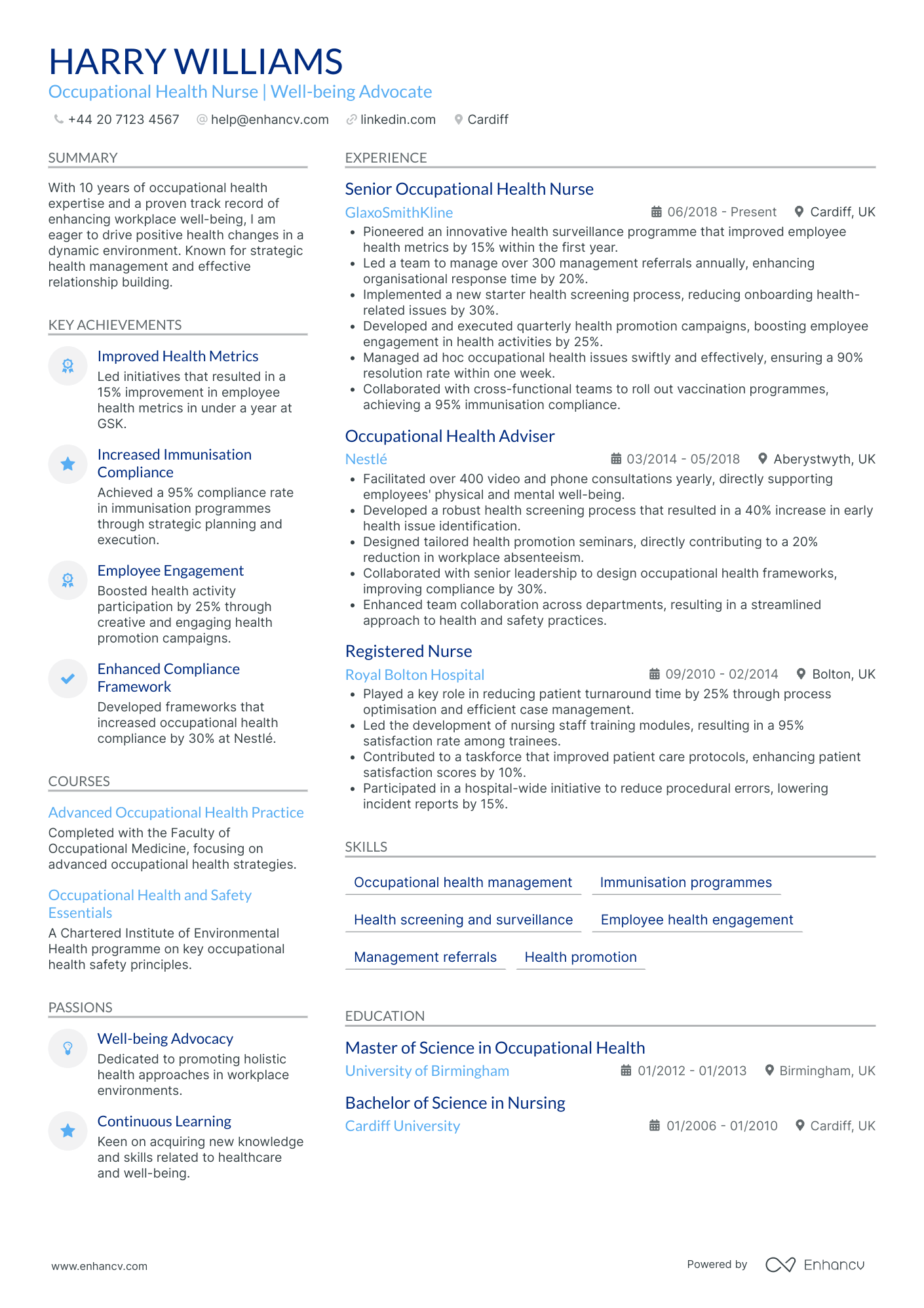Ensuring accurate documentation of patient care and treatment plans is a significant CV challenge for you, the practice nurse. Our comprehensive guide provides clear steps and best practices to enhance your record-keeping skills and ensure your CV reflects the high-quality care you provide.
- Applying the simplest CV design, so that recruiters can easily understand your expertise, skills, and professional background;
- Ensuring you stand out with your header, summary or objective statement, and a designated skills section;
- Creating your CV experience section - no matter how much expertise you have;
- Using real life professional CV examples to enhance the structure and outline of your profile.
If you still have no muse to write your professional CV, find some more industry-leading examples.
Resume examples for practice nurse
By Experience
Advanced Practice Nurse
- Structured clarity and conciseness in content presentation - The CV is meticulously organized, presenting a clear hierarchy of information with straightforward headings like education, experience, and achievements. This thoughtful layout enhances readability, allowing decision-makers to quickly pinpoint relevant details such as key milestones and qualifications.
- Demonstrated growth through progressive career trajectory - Edward Mitchell's career path demonstrates a clear upward trajectory, from a Registered Nurse to an Advanced Nurse Practitioner. Each role details added responsibilities and achievements, indicative of professional growth and dedication to improving patient care and leadership capabilities.
- Impactful achievements with measurable improvements - The CV effectively highlights significant achievements, such as the 50% improvement in patient satisfaction and the 20% decrease in patient recovery time. These metrics are not just numbers; they underscore Edward's ability to implement successful patient-driven initiatives that directly enhance healthcare quality and patient outcomes.
Lead Practice Nurse
- Emphasis on Leadership and Mentoring - The CV highlights Joshua Patel's strong leadership abilities, particularly through his role in mentoring a nursing team of 15 at NHS Berkshire, which directly correlates with the 30% improvement in team performance and patient satisfaction. This showcases his ability to foster team development and enhance operational efficiency.
- Clear Career Progression in Nursing - The career trajectory of moving from a Practice Nurse to a Senior Practice Nurse and eventually to a Lead Practice Nurse reflects significant professional growth. Each role illustrates an expanding scope of responsibilities, from clinical audits to implementing innovative patient care protocols, indicating Joshua's consistent drive for advancement and specialization within the healthcare sector.
- Specialization in Diabetes Management - The CV uniquely distinguishes Joshua with specific expertise in diabetes care, as evidenced by achievements like reducing emergency hospital visits by implementing new insulin titration protocols. His advanced training and contributions to diabetes management launch him as a knowledgeable professional in a critical area of healthcare.
Senior Practice Nurse
- Comprehensive and Structured Presentation - The CV is exceptionally well-organized, presenting information in a clear, concise manner. Sections are clearly delineated, allowing for easy navigation through the candidate’s credentials, experiences, skills, and achievements, ensuring that no important detail is overlooked.
- Steady Career Growth in Healthcare Management - Noah's career trajectory reveals significant growth from operational management roles to a leadership position as a Clinical Care Manager. This progression underscores a consistent increase in responsibilities, indicating not only professional development but also a deepening expertise in clinical care and organizational management.
- Innovative Use of Clinical Governance - The CV highlights unique industry-specific methodologies, such as the development of comprehensive audit systems and the integration of patient feedback into service improvements. This demonstrates a sophisticated understanding of clinical governance and a strategic approach to enhancing healthcare delivery.
Locum Practice Nurse
- Structured and Clear Presentation - The CV is organized with coherent sections that clearly display the candidate's skills, experience, education, and achievements. Each section succinctly provides relevant details, with bullet points that enhance readability. This structured format allows for quick grasp of the candidate's qualifications and experience.
- Illustrates Career Growth and Professional Development - Henry White's trajectory from a Registered Nurse to a Locum Practice Nurse showcases a progressive career path. This advancement highlights his capability and dedication to developing expertise in specialized areas such as chronic care and patient management, which is particularly pertinent to his role as a locum nurse.
- Comprehensive Section on Industry-Specific Skills - The CV includes a detailed list of skills that are specifically tailored to healthcare and nursing, such as Chronic Disease Management and Vaccination Administration. This emphasizes the candidate's focus on specialized treatment approaches and innovative patient care methodologies, pertinent for modern healthcare environments.
By Role
General Practice Nurse
- Structured with clarity and precision - The CV effectively organizes information in a coherent manner, ensuring each section is clearly defined and easy to navigate. This structure allows for concise delivery of content while highlighting key experiences and skills aligned with the role of a Practice Nurse. The clear section headings and bullet points aid in delivering information succinctly, enabling quick assessment of relevant qualifications.
- Progressive career trajectory - Charlie Thomas's career path illustrates steady growth and increasing responsibilities, moving from a Registered Nurse to a Practice Nurse. This progression underscores their capability and willingness to take on elevated roles within healthcare settings, showcasing a commitment to advancing their professional expertise and adaptability to different environments such as NHS Greater Glasgow and Clyde, Bupa Health Clinics, and BMI Healthcare.
- Innovative patient care methodologies - The CV highlights Charlie's dedication to employing industry-specific tools and protocols, such as integrating electronic record management and developing disease prevention educational materials. These elements demonstrate a proactive approach to improving patient care efficiency and outcomes, emphasizing Charlie's contribution to enhancing clinical practices through innovation and technology adoption.
Specialist Practice Nurse in Cardiology
- Structured and Conclusive Career Path - The CV demonstrates a clear trajectory of increased responsibility and expertise in the cardiology nursing field, showcasing the candidate’s shift from general cardiac nurse duties to high-impact roles such as a Clinical Nurse Specialist. This progression is supported with details of leadership in service development, highlighting a strategic career growth path.
- Innovative Approach to Cardiology Patient Care - Unique to this CV is the focus on pioneering initiatives such as the nurse-led Rapid Access Chest Pain Clinics. These initiatives are not only innovative but have had significant real-world impact, improving patient response times by 25% and showing a clear understanding of patient management and service delivery in a specialized medical field.
- Soft Skills and Leadership Excellence - The candidate emphasizes excellent communication skills and collaborative leadership in improving patient satisfaction and medical service standards. They have consistently led efforts to enhance staff competencies and satisfaction, and they have managed interdisciplinary teams effectively - all of which are invaluable in a clinical and patient-centric setting.
Practice Nurse in Paediatrics
- Structured and comprehensive CV format - This CV is effectively structured with clearly labeled sections, facilitating easy navigation. Each section is concise yet descriptive, allowing readers to quickly grasp the candidate's qualifications and experience. The use of bullet points enhances readability and highlights key achievements and responsibilities.
- Well-documented career progression and leadership roles - Finley Robinson's career trajectory reveals significant professional growth, beginning as a Registered Nurse and advancing to an Advanced Nurse Practitioner role. The progression showcases increased responsibilities, leadership in safeguarding protocols, and management of nursing staff, illustrating a clear pathway of advancement and professional development in nursing.
- Incorporation of impactful achievements with quantifiable results - The CV strategically emphasizes achievements with tangible impacts, such as implementing a digital record-keeping system that improved documentation accuracy by 25%. Quantifying outcomes in terms of percentages and numbers provides a compelling demonstration of Finley's contributions to enhancing patient care and operational efficiency.
Practice Nurse in Geriatrics
- Strategically Structured Content - The CV is well-organized, featuring clearly defined sections that allow for easy navigation and present the information concisely. Each segment builds upon the last, creating a cohesive narrative that effectively highlights the applicant's qualifications, experiences, and achievements relevant to their role in geriatric medicine.
- Impressive Career Advancement - Poppy Griffiths showcases a clear upward trajectory within the field of geriatric medicine, moving from a Geriatric Medicine Specialist to a Consultant Geriatrician. Each position reflects an increase in responsibility and influence, illustrating a commitment to professional growth and leadership in acute care settings.
- Exceptional Achievements with Impact - The CV emphasizes key achievements not only by citing quantifiable results but also by explaining their real-world impact. For instance, the implementation of an Acute Frailty Pathway resulted in a significant reduction in patient stay lengths, directly enhancing the efficiency and effectiveness of care for high-risk individuals.
Practice Nurse in Oncology
- Structured and Clear Presentation - The CV is neatly organized with distinct sections, making it easy to navigate and pinpoint specific information. The use of bullet points in the experience section provides clarity and allows for the quick identification of key responsibilities and achievements.
- Focused Career Advancement - Daisy Shaw’s career progression is evident, moving from a Staff Nurse to a Clinical Nurse Specialist with increased responsibilities, highlighting a focused trajectory within the oncology field. This upward movement illustrates commitment to her profession and continuous personal development.
- Leadership and Innovation in Healthcare - The CV showcases Daisy's leadership capabilities through her role in implementing nurse-led clinics and process optimization initiatives. These actions not only demonstrate her leadership but also her commitment to innovation and improving patient outcomes in neuro-oncology care.
Practice Nurse in Mental Health
- Comprehensive Leadership and Mentorship Experience - Evie Perry's CV highlights her expertise in guiding teams and enhancing workforce capabilities. Her role as a Senior Mental Health Nurse involved leading a team, implementing skill-sharing workshops, and launching a mentorship program that significantly increased team confidence and competence.
- Adaptability and Implementation of Novel Strategies - The CV demonstrates her ability to adapt and innovate, as evidenced by her successful implementation of a new care assessment protocol, leading to a 30% reduction in patient readmissions. This showcases her proactive approach and capacity to introduce effective methodologies in clinical settings.
- Impactful Achievements and Outcome-driven Approaches - The CV meticulously presents Evie's achievements that go beyond numbers by emphasizing the tangible impact of her efforts. By spearheading initiatives that improved patient outcomes, addressed staff well-being, and increased overall service efficiency, she clearly communicates her impact on the organizations she worked with.
Community Practice Nurse
- Structured and Clear Presentation - The CV is well-organized, with distinct sections for experience, education, skills, courses, achievements, languages, and passions. This clarity allows for quick navigation and ensures key information is easily accessible, making the document both concise and informative.
- Consistent Career Growth - Louis Wood's career trajectory demonstrates a clear path of growth and specialization in diabetes care. Starting as a Registered Nurse and progressing to roles like Paediatric Diabetes Nurse and Diabetes Specialist Nurse illustrates dedication and expertise development in children's services and diabetes management.
- Industry-Specific Achievements with Impact - The CV highlights substantial achievements with significant business relevance, such as a 30% increase in patient satisfaction through enhanced diabetes education and a 15% reduction in emergency admissions. Such metrics not only showcase Louis's effectiveness but also highlight the broader impact of his initiatives on healthcare outcomes.
Practice Nurse in Dermatology
- Clear Structure and Conciseness - The CV is structured neatly with each section clearly demarcating information, making it easy for the reader to follow the candidate's career journey. Each role is highlighted with bullets that succinctly communicate responsibilities and outcomes, demonstrating clarity and brevity in presentation.
- Progressive Career Trajectory - Sienna West's career shows a clear progression from a Clinical Nurse Specialist to a Senior Clinical Nurse, indicating growth in responsibility and expertise. This upward trajectory reflects a deepening specialization in dermatology and chronic care management, illustrating her commitment and advancement within her field.
- Impactful Achievements - The CV shines in how it ties achievements to business results, such as a 20% increase in patient satisfaction and a 50% reduction in medication errors. These outcomes not only quantify Sienna's effectiveness but also underscore her contribution to enhancing patient care and operational efficiency.
Practice Nurse in Obstetrics and Gynaecology
- Structured Clarity in Presentation - This CV is presented with a high degree of clarity and structure, making it easy for the reader to navigate through the various sections. Each section is concisely presented, with the use of bullet points effectively highlighting key achievements and responsibilities without overwhelming the reader.
- Progressive Career Trajectory - The career progression of Leo Brown is notably impressive, showcasing steady growth from a Junior Specialist to a Senior Obstetrician and Gynaecologist. This upward movement within the healthcare industry underscores his dedication, expertise, and ability to take on increased responsibility and leadership roles.
- Achievements with Significant Impact - The CV emphasizes achievements that not only highlight personal successes but also demonstrate meaningful impacts on healthcare delivery. For instance, notably improving patient satisfaction by 30% and reducing post-operative complications by 25% reflect a strong alignment with organizational goals and patient care enhancement.
Practice Nurse in Respiratory Medicine
- Emphasizes Clinical Leadership and Patient Care - The CV opens with a direct emphasis on Alexander's role as a Respiratory Nurse Specialist, underscoring their dedication to clinical leadership and patient-focused care. This is evident through the structured presentation of their responsibilities and achievements, which remain consistently aligned with improving patient outcomes.
- Demonstrates Growth and Specialized Expertise - A clear trajectory of career progression is visible from Staff Nurse to Senior Respiratory Nurse within various reputable institutions. This showcases Alexander's advancement in the healthcare industry, specifically highlighting specialized expertise in respiratory medicine, which is crucial for advancing to a leadership position.
- Highlights Quantifiable Achievements in Healthcare - Each role described in the CV includes notable achievements backed by quantifiable data, such as reducing patient readmissions by 20% and improving patient satisfaction by 15%. These figures are not only impressive but also demonstrate Alexander's impact on healthcare quality and service delivery, reflecting their commitment to excellence in patient care.
Practice Nurse in Diabetes Care
- Content Presentation with Clinical Precision - The CV is structured with a clear and concise presentation, effectively guiding readers through sections of the candidate's qualifications and experiences. Each role is detailed with bullet points that succinctly convey the scope of responsibilities and achievements, making it easy to identify key competencies such as diabetes management and patient education.
- Career Trajectory in Healthcare Excellence - Thomas Walker's career progression from Registered Nurse to Clinical Nurse Specialist outlines a clear trajectory of growth and specialization within the healthcare sector, emphasizing his commitment to diabetes care. This upward mobility, marked by promotions and increasing responsibilities, highlights his expertise and leadership in managing patient care innovations.
- Innovative Industry-Specific Methods - The CV speaks to the candidate's proficiency in utilizing advanced tools and methodologies, such as the implementation of a digital documentation system and interdisciplinary communication strategies. These elements not only accentuate his technical depth but also his ability to streamline healthcare operations, improve patient outcomes, and foster cohesive treatment plans.
Practice Nurse in Palliative Care
- Clear and Structured Presentation - This CV excels in clarity and organization, systematically presenting the candidate’s information in a cohesive manner. Sections are well-defined and ordered logically, making it easy for readers to follow the career journey and achievements effortlessly. The concise bullet points allow for quick reading and highlight key responsibilities and successes effectively.
- Consistent Career Advancement - Finley Robinson’s career trajectory demonstrates progressive growth within the field of palliative and community care. Starting as a Palliative Care Nurse and moving up to a Specialist Palliative Care Nurse, the CV highlights consistent promotions based on expertise and leadership skills. This advancement reflects a strong commitment to the field and the accumulation of specialized knowledge over time.
- Specialized Skills and Methodologies - The CV showcases industry-specific skills such as complex symptom management, clinical decision-making, and crisis intervention, which are crucial in the healthcare context. Additional courses in advanced symptom management and cultural competence further underscore the candidate’s dedication to excelling in specialized palliative care methodologies, ensuring they bring technical depth to their role.
Practice Nurse in Orthopaedics
- Clear and Structured Presentation - The CV is well-organized, featuring distinct sections for experience, education, skills, and achievements. This clarity allows readers to quickly understand the candidate's background and qualifications. Each role and achievement is concisely explained, demonstrating a focus on impactful results.
- Demonstrated Career Growth - Sienna has shown a clear trajectory of professional advancement, moving from a Staff Nurse to a Senior Orthopaedic Nurse and now pursuing a Master’s degree to become an Advanced Clinical Practitioner. This progression highlights her dedication to career development and leadership within the healthcare field.
- In-depth Orthopaedic Expertise - The CV features specialized knowledge in orthopaedics, underlined by targeted courses such as Advanced Pain Management in Orthopaedics and her practical contributions to improving orthopaedic care protocols. This depth is bolstered by her direct work in a renowned hospital setting.
Practice Nurse in Neurology
- Comprehensive Career Growth - Henry White's CV reflects a clear and impressive career trajectory in the field of neurology nursing. Starting as a Staff Nurse and advancing to a Senior Registered Nurse, his progression showcases dedication to the specialty and a commitment to advancing his expertise and leadership within neurology units. Each step of his career is marked by increased responsibility and impactful contributions, such as leading a team of nurses and managing complex cases.
- Diverse Skill Set and Leadership - The CV highlights a strong combination of technical nursing skills, such as medication management and neurological assessment, paired with soft skills in communication and team collaboration. Henry's leadership abilities are underscored by his role in spearheading quality improvement projects and developing training programs, demonstrating his capacity to guide teams effectively while fostering an environment of continuous learning and improvement.
- Impactful Achievements with Business Relevance - Achievements within the CV are not merely numerical but tied to substantial improvements in patient care and operational efficiency. Projects Henry led, such as reducing medication errors by 30% and improving patient discharge times by 20%, directly enhance the healthcare facility's effectiveness and patient satisfaction, adding measurable value to his employer's services and reputation.
Practice Nurse in Emergency Medicine
- Structured and clear content presentation - Jacob's CV is organized in a way that allows the reader to easily navigate through various sections. Each role is effectively bullet-pointed, making his responsibilities and achievements immediately clear. Important metrics and outcomes are highlighted, focusing on clarity and succinctness, allowing key information to stand out at a glance.
- Impressive career trajectory in emergency medicine - Jacob's progression through different roles within emergency settings showcases a consistent upward trajectory. From starting as a Clinical Fellow to becoming an Emergency Department Registrar, his career reflects both growth and dedication to the field of clinical medicine. This trajectory demonstrates both his drive and capacity to take on increasing responsibilities.
- Significant achievements and their impact - The CV places emphasis on achievements that not only highlight Jacob's skills but also their direct impact on patient care and departmental efficiency. For instance, implementing a triage protocol and quality improvement projects not only improved critical response times and reduced errors but also underscored his ability to drive strategic initiatives that result in tangible improvements in healthcare delivery.
Practice Nurse in Occupational Health
- Strategic Health Initiatives - Harry's CV showcases a proactive approach through his leadership in health surveillance and promotion campaigns, leading to significant improvements in employee health metrics and engagement. This indicates a strategic mindset focused on long-term health benefits for organizations.
- Cross-functional Collaboration and Leadership - The document highlights Harry's ability to work with diverse teams and leadership cohorts, leading vaccination programs and health frameworks that emphasize his collaborative nature and influence across different organization levels.
- Innovative Problem Solving - Harry’s experience reflects a strong emphasis on reducing procedural inefficiencies and issues, such as decreasing onboarding health-related issues and enhancing response times for management referrals, thereby demonstrating his problem-solving acumen in occupational health settings.
How to ensure your profile stands out with your practice nurse CV format
It's sort of a Catch 22. You want your practice nurse CV to stand out amongst a pile of candidate profiles, yet you don't want it to be too over the top that it's unreadable. Where is the perfect balance between your CV format simple, while using it to shift the focus to what matters most. That is - your expertise. When creating your practice nurse CV:
- list your experience in the reverse chronological order - starting with your latest roles;
- include a header with your professional contact information and - optionally - your photograph;
- organise vital and relevant CV sections - e.g. your experience, skills, summary/ objective, education - closer to the top;
- use no more than two pages to illustrate your professional expertise;
- format your information using plenty of white space and standard (2.54 cm) margins, with colours to accent key information.
Once you've completed your information, export your practice nurse CV in PDF, as this format is more likely to stay intact when read by the Applicant Tracker System or the ATS. A few words of advice about the ATS - or the software used to assess your profile:
- Generic fonts, e.g. Arial and Times New Roman, are ATS-compliant, yet many candidates stick with these safe choices. Ensure your CV stands out by using a more modern, and simple, fonts like Lato, Exo 2, Volkhov;
- All serif and sans-serif fonts are ATS-friendly. Avoid the likes of fancy decorative or script typography, as this may render your information to be illegible;
- Both single- and double-column formatted CVs could be assessed by the ATS;
- Integrating simple infographics, icons, and charts across your CV won't hurt your chances during the ATS assessment.
PRO TIP
Use bold or italics sparingly to draw attention to key points, such as job titles, company names, or significant achievements. Overusing these formatting options can dilute their impact.
The top sections on a practice nurse CV
- Professional Summary showcases your nursing philosophy and dedication.
- Nursing Qualifications highlight your specific education and certifications.
- Clinical Experience demonstrates your hands-on nursing skills and patient care.
- Nursing Skills section focuses on specialized techniques and practices you excel in.
- Professional Development details ongoing learning and commitment to the nursing field.
What recruiters value on your CV:
- Highlight your clinical skills and nursing qualifications, making sure to mention any specific certifications or training relevant to practice nursing such as immunisation, cervical screening, or chronic disease management.
- Emphasise your experience in patient education and health promotion, reflecting your ability to support patients in understanding their health and wellness.
- Showcase your proficiency in clinical tasks and procedures unique to a practice nurse role like wound care, ECGs, and triage competencies.
- Demonstrate your ability to work autonomously and within a multidisciplinary team, including your collaboration with general practitioners and other healthcare professionals.
- Include examples of your administrative and organisational skills, which are crucial in managing patient records, appointments, and coordinating care within a general practice setting.
Recommended reads:
Making a good first impression with your practice nurse CV header
Your typical CV header consists of Your typical CV header consists of contact details and a headline. Make sure to list your professional phone number, email address, and a link to your professional portfolio (or, alternatively, your LinkedIn profile). When writing your CV headline , ensure it's:
- tailored to the job you're applying for;
- highlights your unique value as a professional;
- concise, yet matches relevant job ad keywords.
You can, for examples, list your current job title or a particular skill as part of your headline. Now, if you decide on including your photo in your CV header, ensure it's a professional one, rather than one from your graduation or night out. You may happen to have plenty more questions on how to make best the use of your CV headline. We'll help you with some real-world examples, below.
Examples of good CV headlines for practice nurse:
- Practice Nurse | BSc in Adult Nursing | Chronic Disease Management | 5+ Years of Experience
- Senior Practice Nurse | Immunisation Lead | Diabetic Care Expert | Advanced Nurse Practitioner Qualification
- Lead Practice Nurse | Women's Health Specialist | Prescriber | 10 Years' Clinical Practice
- Practice Nurse Manager | Team Leadership | Clinical Governance | Non-medical Prescriber | 8 Years of Service
- Community Practice Nurse | Health Promotion Champion | Wound Care Proficiency | 12 Years' Dedication
- Junior Practice Nurse | Infection Control Enthusiast | BSc Honours Nursing Graduate | Committed to Patient Care
Opting between a practice nurse CV summary or objective
Within the top one third of your practice nurse CV, you have the opportunity to briefly summarise your best achievements or present your professional goals and dreams. Those two functions are met by either the CV summary or the objective.
- The summary is three-to-five sentences long and should narrate your best successes, while answering key requirements for the role. Select up to three skills which you can feature in your summary. Always aim to present what the actual outcomes were of using your particular skill set. The summary is an excellent choice for more experienced professionals.
- The objective is more focused on showcasing your unique value as a candidate and defining your dreams and ambitions. Think about highlighting how this current opportunity would answer your career vision. Also, about how you could help your potential employers grow. The objective matches the needs of less experienced candidates, who need to prove their skill set and, in particular, their soft skills.
Still not sure about how to write your CV opening statement? Use some best industry examples as inspiration:
CV summaries for a practice nurse job:
- With over 12 years of robust experience in primary care, a seasoned practice nurse prides herself on compassionate patient-centred care, adept in chronic disease management, and a proven track record of implementing successful health promotion programs, leading to a 20% increase in patient engagement.
- Diligent nursing professional with 15 years’ experience in fast-paced hospital settings, transitioning to practice nursing with a prolific background in acute patient care, triaging, and emergency response, aiming to apply extensive clinical skills to manage and educate patient populations in a community health environment.
- An educator for 8 years, eager to transfer strong communication and organizational skills into nursing practice, having recently obtained an RN qualification with a focus on primary health care, and driven by a commitment to making a tangible difference in the lives of patients and their families.
- Former military medic with 10 years' experience in high-pressure environments, now seeking to contribute a robust skill set in trauma care and emergency response to a practice nursing role, bringing a disciplined approach and exceptional leadership abilities developed during service.
- Recently qualified nurse with a BSc in Nursing, passionate about providing holistic care, seeking to leverage hands-on practicum experience in a community health setting to establish a foundation in practice nursing, with an emphasis on patient education and preventive health strategies.
- Graduate with comprehensive theoretical knowledge in nursing and a fresh perspective on patient care, aiming to apply learning experiences garnered through various clinical placements and volunteer work to build a career in practice nursing with a focus on continuous professional development.
Narrating the details of your practice nurse CV experience section
Perhaps you've heard it time and time again, but, how you present your experience is what matters the most. Your CV experience section - that details your work history alongside your accomplishments - is the space to spotlight your unqiue expertise and talents. So, avoid solely listing your responsibilities, but instead:
- adverts' keywords and integrate those in your experience section;
- Use your CV to detail how you've been promoted in the past by including experience in the reverse chronological order.
Before you start writing your practice nurse CV experience section, dive into some industry-leading examples on how to structure your bullets.
Best practices for your CV's work experience section
- Conducted initial patient assessments, taking detailed histories and performing basic diagnostic tests to support patient diagnosis and treatment planning.
- Administered vaccinations and immunisations in line with current public health guidelines and maintained accurate records of all inoculations.
- Managed wound care for patients, including dressing changes, suture removal, and providing advice on home care to minimise infection risk.
- Performed routine screening procedures, such as cervical smears, blood pressure monitoring, and cholesterol checks, contributing to early detection of health issues.
- Liaised with multidisciplinary teams to develop and implement patient care plans, ensuring a coordinated approach to treatment and support services.
- Provided patient education on chronic disease management, promoting self-care and empowering patients to take control of their health conditions such as diabetes and asthma.
- Facilitated health promotion clinics focused on areas such as smoking cessation, weight management, and sexual health, helping to improve community health outcomes.
- Utilised electronic health record systems to document patient interactions, ensuring continuity of care and compliance with legal and professional standards.
- Collaborated with General Practitioners and other healthcare professionals to manage acute and chronic health issues, offering comprehensive care within a busy practice environment.
- Initiated a diabetes management programme that educated over 200 patients on glucose control, leading to a clinic-wide 25% improvement in diabetes management outcomes.
- Carried out 50+ health screenings per week, including blood pressure and cholesterol tests, contributing to early detection of potential health issues in patients.
- Led the implementation of a new electronic health records system, training 15 staff members, which increased efficiency of patient data retrieval by 40%.
- Standardised treatment protocols for chronic diseases such as asthma and COPD, reducing emergency hospital admissions by 15% over a two-year period.
- Coordinated with a team of 10 nurses to deliver immunisation programmes, successfully immunising 95% of eligible children in the practice.
- Performed minor surgeries including mole removals and joint injections, averaging 20 procedures per month with a 98% patient satisfaction rate.
- Developed a comprehensive women's health programme, increasing the number of annual cervical screenings conducted by 30%.
- Managed anticoagulation monitoring for over 150 patients, ensuring INR levels remained within target range 92% of the time.
- Orchestrated a series of public health awareness workshops, leading to a 20% increase in patient engagement with preventative care services.
- Spearheaded a vaccination drive that reached over 500 patients during a severe influenza outbreak, minimising the spread of infection within the community.
- Supervised the transition of the clinic’s patient records to a digital format, ensuring a seamless transfer for 3,000+ patients' records.
- Facilitated weekly chronic pain management clinics, providing tailored support and therapy plans for more than 100 patients, significantly enhancing their quality of life.
- Implemented a triage system in the walk-in centre, which led to a 20% reduction in waiting times for urgent care patients.
- Developed and maintained collaborative relationships with local pharmacists to improve medication compliance, affecting 1,000+ patients.
- Conducted community outreach for older adults, increasing accessibility to primary care services by 25% within the elderly population.
- Launched a digital portal for remote patient consultations during the COVID-19 pandemic, accommodating over 300 virtual visits per month.
- Initiated a hypertension control pilot study with 50 patients, which successfully reduced average blood pressure readings by 10 mmHg over six months.
- Oversaw the practice's annual flu immunisation campaign, resulting in a record high 2,000 patients receiving their vaccine in the 2020 season.
- Pioneered a mental health first-aid programme that trained all clinic employees, markedly enhancing the support network for patients with mental health conditions.
- Conducted comprehensive travel health consultations and vaccinations for over 60 patients monthly, significantly reducing the risk of disease transmission upon their return.
- Managed the baby clinic, supporting new parents and ensuring over 500 infants received their developmental checks and vaccinations on schedule.
- Collaborated in a research project on preventing hospital readmissions, which informed the creation of practice-based follow-up care plans for discharged patients.
- Directed the annual health promotion initiative, focusing on obesity and lifestyle diseases, engaging with 300+ patients leading to a 10% collective weight loss.
- Administered first contact physiotherapy assessments, offering early intervention for musculoskeletal conditions to over 20 patients per week.
Swapping your professional experience (when you have none) with skills and more
Never underestimate the importance of relevancе when it comes to your practice nurse CV. Even if you don't happen to have much or any standard (full-time contract) professional experience, this doesn't mean you shouldn't apply for the role. Instead of a bespoke CV experience section:
- Showcase more prominently any internships, part-time roles, and volunteer experience that are applicable to the role and have taught you job-crucial skills;
- Feature a strengths or achievements section with your transferrable skills or talents you've obtained thanks to your work or life experience;
- Write an objective statement that clearly outlines your values as a candidate and defines your career ambitions;
- List your education or certificates that match the job profile closer to the top of your CV.
Recommended reads:
PRO TIP
Include examples of how you adapted to new tools, environments, or work cultures, showing your flexibility.
The CV skills' divide: between hard and soft skills
Of course, you may have read the job requirements plenty of times now, but it's key to note that there is a difference between technical and personal skills. Both are equally relevant to your job application. When writing about your skill set, ensure you've copy-pasted the precise skill from the job requirement. This would not only help you ensure you have the correct spelling, but also pass any Applicant Tracker System (ATS) assessments.
- Hard skills show your technological capabilities. Or whether you'll be a good technical fit to the organisation. Ensure you've spotlighted your hard skills in various sections of your CV (e.g. skills section, projects, experience) by including the technology and what you've attained;
- Soft skills pinpoint your personality and people or communication skills, hinting at if you'll easily accomodate into the team or organisation. Quantify your soft skills in your CV achievements, strengths, summary/objective, and experience sections. Always support your soft skills with how they've helped you grow as a professional.
Top skills for your practice nurse CV:
Patient Care
Clinical Skills
Wound Dressing
Immunisation
Venipuncture
Diagnostic Testing
Medication Administration
Health Assessment
Chronic Disease Management
Infection Control
Communication
Empathy
Teamwork
Time Management
Problem-Solving
Adaptability
Attention to Detail
Professionalism
Resilience
Cultural Competency
PRO TIP
Order your skills based on the relevance to the role you're applying for, ensuring the most pertinent skills catch the employer's attention first.
Education and more professional qualifications to include in your practice nurse CV
If you want to showcase to recruiters that you're further qualified for the role, ensure you've included your relevant university diplomas. Within your education section:
- Describe your degree with your university name(-s) and start-graduation dates;
- List any awards you've received, if you deem they would be impressive or are relevant to the industry;
- Include your projects and publications, if you need to further showcase how you've used your technical know-how;
- Avoid listing your A-level marks, as your potential employers care to learn more about your university background.
Apart from your higher education, ensure that you've curated your relevant certificates or courses by listing the:
- name of the certificate or course;
- name of the institution within which you received your training;
- the date(-s) when you obtained your accreditation.
In the next section, discover some of the most relevant certificates for your practice nurse CV:
PRO TIP
Focus on describing skills in the context of the outcomes they’ve helped you achieve, linking them directly to tangible results or successes in your career.
Recommended reads:
Key takeaways
Here are five things you need to remember about writing your practice nurse CV for success:
- Sort your experience based on the reverse chronological order, starting with your most recent career items, to showcase how you've grown your career;
- Include within your CV header your relevant contact details, a headline that could spotlight your unique value, and a photo - if you're applying for roles outside the UK or US;
- Decide to use the CV summary, if you happen to have more professional experience, and an objective, if you want to showcase your career goals;
- Within the experience section, write your bullets using action verbs, skills, and success, instead of just merely listing your on-the-job responsibilities;
- Prove your technical skills, using your education and certificates, and your soft skills, with your achievements and strengths sections.
